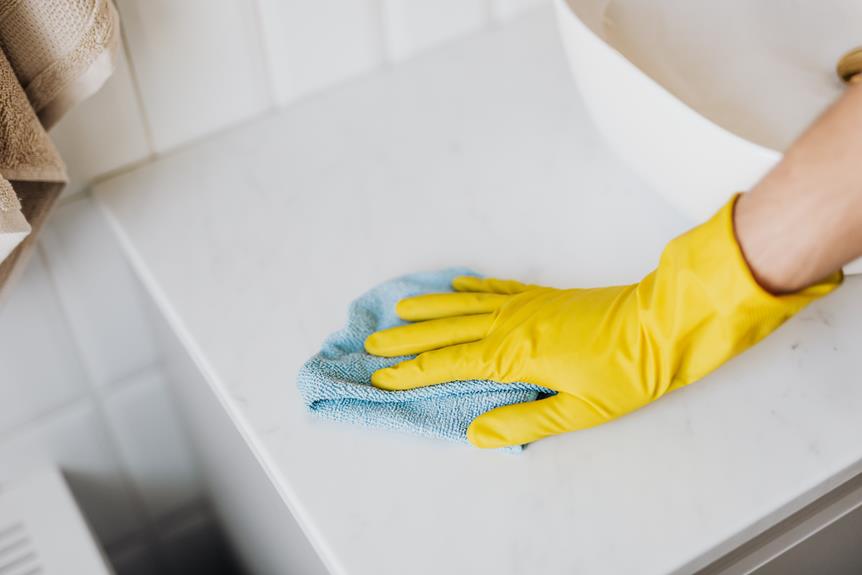You may wonder which adhesive is best for fabrics: rubber or acrylic.
Each type has its own strengths and weaknesses when it comes to bonding fabric materials. Understanding the characteristics of rubber and acrylic adhesives is crucial in making an informed decision.
This comparison will delve into the:
- Bonding strength
- Fabric compatibility
- Durability
- Flexibility
- Application techniques
- Environmental considerations
- Cost and availability
By weighing these factors, you can determine which adhesive best suits your specific fabric bonding needs.
Key Takeaways
- Acrylic adhesives offer superior bonding strength and durability for fabric applications.
- Acrylic adhesives are compatible with various fabric types, including cotton, polyester, nylon, and silk.
- Proper surface preparation and application techniques are crucial for achieving a strong and long-lasting bond.
- Consider environmental factors and choose adhesives made from sustainable materials that can be composted or recycled.
Understanding Rubber Adhesives
When choosing an adhesive for fabrics, understanding the properties of rubber adhesives is crucial for achieving durable and flexible bonds. Rubber adhesives are composed of synthetic rubber polymers, tackifying resins, and various additives. The chemical composition of rubber adhesives gives them a unique ability to form strong bonds with fabric materials. They're particularly effective for bonding fabrics such as cotton, nylon, polyester, and blends.
One of the key advantages of rubber adhesives for fabrics is their heat resistance. These adhesives can withstand a wide range of temperatures, making them suitable for fabrics that may be exposed to heat during their lifetime. Whether it's in the manufacturing process or everyday use, rubber adhesives maintain their bond strength even under conditions of elevated temperature.
Understanding the chemical composition and heat resistance of rubber adhesives is essential for selecting the right adhesive for fabric applications. When choosing an adhesive for fabrics, consider the specific properties of rubber adhesives to ensure a strong and enduring bond that meets the requirements of your fabric project.
Exploring Acrylic Adhesives
An essential aspect to consider when evaluating adhesives for fabric applications is the versatility offered by acrylic adhesives. Acrylic adhesives have gained popularity due to their exceptional bonding techniques and adaptability to various fabric types. Here's what makes acrylic adhesives a top choice for fabric bonding:
- Versatility: Acrylic adhesives are suitable for a wide range of fabrics, including natural fibers like cotton and wool, as well as synthetic fabrics such as polyester and nylon. This versatility makes them a go-to option for diverse fabric bonding needs.
- Durability: Acrylic adhesives provide strong and durable bonds, ensuring that fabric items withstand frequent use, washing, and environmental factors without compromising the bond strength.
- Quick setting: These adhesives typically have a fast setting time, allowing for efficient production processes and rapid repairs.
- Resistance: Acrylic adhesives offer resistance to moisture, heat, and chemicals, making them suitable for fabrics that are exposed to challenging environmental conditions.
Understanding the unique characteristics and benefits of acrylic adhesives is crucial for mastering fabric bonding techniques and achieving reliable, long-lasting results.
Bonding Strength Comparison
When comparing the bonding strength of rubber and acrylic adhesives, it's important to consider their durability, fabric compatibility, and application versatility.
Rubber adhesives are known for their strong bonding capabilities, making them suitable for heavy-duty fabrics and materials that require a resilient bond.
On the other hand, acrylic adhesives offer a more versatile application, providing a strong bond across a wide range of fabric types and applications.
Understanding the differences in bonding strength between these two adhesive types can help you choose the best option for your specific fabric bonding needs.
Rubber Vs Acrylic Durability
You'll find that acrylic adhesives generally provide a stronger bonding strength for fabrics than rubber adhesives. When comparing the durability of rubber and acrylic adhesives for fabrics, the following points should be considered:
- Environmental Resistance: Acrylic adhesives offer better resistance to environmental factors such as moisture, heat, and UV exposure, contributing to their long-term performance.
- Flexibility: Acrylic adhesives maintain their flexibility over time, ensuring that the bonded fabrics can withstand stretching and movement without compromising the bond strength.
- Chemical Resistance: Acrylic adhesives exhibit superior resistance to various chemicals, making them suitable for fabrics that may be exposed to solvents or cleaning agents.
- Aging and Yellowing: Acrylic adhesives are less prone to yellowing and aging, preserving the appearance and integrity of the fabric bond over extended periods.
Considering these factors, acrylic adhesives are generally more durable than rubber adhesives for fabric bonding.
Fabric Compatibility Differences
In the comparison between rubber and acrylic adhesives for fabrics, acrylic adhesives demonstrate superior bonding strength and compatibility with a variety of fabric types. Fabric adhesion is significantly enhanced with acrylic adhesives due to their ability to form strong and flexible bonds with fabrics such as cotton, polyester, nylon, and blends.
Acrylic adhesives are particularly effective for applications requiring high tensile strength and resistance to both washing and dry cleaning processes. When considering adhesive selection for fabrics, it's crucial to prioritize compatibility and durability.
Acrylic adhesives offer a versatile solution for a wide range of fabric types, ensuring reliable adhesion that withstands the stresses of everyday use. Understanding the fabric compatibility differences between rubber and acrylic adhesives is essential for achieving optimal bonding strength in various fabric applications.
Application Versatility Contrast
To understand the application versatility contrast and bonding strength comparison between rubber and acrylic adhesives for fabrics, let's delve into their specific characteristics and performance in various fabric applications.
- Versatility Comparison: Rubber adhesives are known for their flexibility and suitability for a wide range of fabric types, including natural and synthetic fabrics, as well as blends.
- Fabric Adhesion: Acrylic adhesives offer excellent adhesion to fabrics, particularly in applications where durability and washability are crucial, making them ideal for items like outdoor gear and sportswear.
- Bonding Strength: Rubber adhesives provide strong initial bonding but may weaken over time, especially when exposed to heat and humidity.
- Durability: Acrylic adhesives exhibit superior resistance to environmental factors, maintaining their bonding strength and integrity over extended periods, ensuring long-lasting fabric adhesion.
Fabric Compatibility
Fabric compatibility is an essential consideration when choosing the right adhesive for your project. Different fabrics have varying levels of durability and react differently to adhesive application. It is crucial to ensure that the adhesive you choose is compatible with the specific fabric you are working with to achieve the best results.
| Fabric Type | Adhesive Recommendation |
|---|---|
| Cotton | Acrylic adhesive is suitable for cotton fabrics due to its flexibility and durability. |
| Polyester | Both rubber and acrylic adhesives can be used with polyester fabrics, but acrylic adhesive offers better long-term adhesion. |
| Silk | Acrylic adhesive is the preferred choice for silk due to its gentle yet strong bonding properties. |
When working with cotton, polyester, or silk fabrics, it is important to select an adhesive that complements the specific characteristics of each fabric. Considering fabric compatibility ensures that the adhesive will effectively bond with the fabric, providing a long-lasting and durable result. Always test a small, inconspicuous area of the fabric with the selected adhesive to ensure compatibility before proceeding with the full application.
Durability and Flexibility
Considering the demands of fabric projects, selecting an adhesive with the right level of durability and flexibility is crucial for achieving long-lasting results. When comparing the durability of rubber and acrylic adhesives for fabric projects, it's essential to consider their ability to withstand various conditions and stresses. Additionally, the flexibility assessment plays a vital role in determining how well the adhesive can move and stretch with the fabric without losing its adhesive properties.
Here are some key points to consider when evaluating the durability and flexibility of adhesives for fabrics:
- Durability Comparison:
- Assess the adhesive's resistance to washing and drying to ensure it can withstand regular fabric care routines.
- Evaluate the adhesive's ability to withstand exposure to sunlight and heat without degradation.
- Flexibility Assessment:
- Consider how well the adhesive maintains its bonding strength when the fabric is stretched or bent.
- Evaluate the adhesive's ability to remain flexible over time, avoiding becoming brittle or stiff with age.
Application Techniques
When applying adhesive to fabrics, it's important to carefully follow the recommended techniques to ensure proper bonding and longevity of the bond.
Start by preparing the fabric surface. Ensure it's clean, dry, and free from any dirt, dust, or residue that could hinder adhesion.
Next, consider the pressure and temperature during application. Applying even pressure across the fabric surface helps the adhesive to bond uniformly, preventing any weak spots. Additionally, the temperature can affect the adhesive's performance. Most adhesives work best within a specific temperature range, so be sure to adhere to the manufacturer's recommendations.
It's essential to avoid extremes of temperature during application and curing, as this can impact the adhesive's ability to form a strong bond.
Environmental Considerations
When considering the environmental impact of adhesives for fabrics, it's important to examine the material biodegradability, eco-friendly production processes, and the recyclability of the adhesive. Assessing these factors can help you make an informed decision that aligns with your environmental values and standards.
Understanding the environmental considerations of rubber and acrylic adhesives is crucial in choosing the best option for your fabric projects.
Material Biodegradability
Choosing an adhesive based on its material biodegradability is essential for minimizing environmental impact when working with fabrics. When considering material biodegradability, keep in mind the following:
- Biodegradability Benefits: Opt for adhesives made from biodegradable materials such as natural rubber or acrylics derived from sustainable sources. These materials break down over time, reducing environmental pollution.
- Sustainable Materials: Look for adhesives labeled as environmentally friendly or sustainable. These products are often made from renewable resources and have minimal ecological impact.
- Certifications: Seek adhesives with certifications such as the Forest Stewardship Council (FSC) or the Programme for the Endorsement of Forest Certification (PEFC), indicating sustainable sourcing and manufacturing practices.
- Disposal: Consider the end-of-life disposal of the adhesive. Choose products that can be safely composted or recycled, further reducing environmental impact.
Eco-Friendly Production Processes
To ensure eco-friendly production processes, prioritize adhesives manufactured using sustainable methods and materials, minimizing environmental impact throughout their lifecycle. Sustainable manufacturing involves using green technology and practices that reduce energy consumption, emissions, and waste. When choosing fabric adhesives, consider the environmental impact of the production process. Look for adhesives from manufacturers committed to sustainable practices, such as using renewable energy sources, reducing water usage, and minimizing waste through recycling and reuse. Below is a comparison table to help you evaluate the eco-friendliness of adhesives based on their production processes:
| Eco-Friendly Production Processes | Adhesive A | Adhesive B | Adhesive C |
|---|---|---|---|
| Uses Sustainable Materials | Yes | No | Yes |
| Energy-Efficient Production | Yes | Yes | No |
| Waste Minimization Practices | Yes | Yes | Yes |
Considering these factors will help you make an informed decision that aligns with your environmental values.
Recyclability of Adhesive
Considering the environmental impact, it's essential to evaluate the recyclability of the adhesives you use in fabric projects. When comparing the recyclability of rubber and acrylic adhesives, it's important to consider the sustainability impact of each option. Here are key points to consider in the recyclability comparison:
- End-of-life disposal: Rubber adhesives are generally more challenging to recycle due to their composition, while acrylic adhesives are often more readily recyclable.
- Environmental impact: Acrylic adhesives are known for their potential to be recycled without the degradation of their performance, making them a more sustainable choice.
- Energy consumption: The recycling process for acrylic adhesives typically requires less energy compared to rubber adhesives, contributing to lower environmental impact.
- Circular economy potential: Acrylic adhesives often offer greater potential for reuse and recycling within a circular economy framework.
Cost and Availability
When comparing rubber and acrylic adhesives for fabrics, consider the cost and availability before making your decision.
In terms of cost comparison, rubber adhesives are generally more affordable than acrylic adhesives. This cost advantage can be significant for large-scale fabric projects or industrial use. However, it's important to note that the price may vary based on the specific brand, quality, and quantity purchased.
In contrast, acrylic adhesives may be slightly more expensive upfront, but they often provide a higher level of durability and longevity. This can result in cost savings over time due to reduced need for reapplication or repairs.
When assessing market availability, both rubber and acrylic adhesives are widely accessible. They can be found in most hardware stores, specialty craft stores, and online retailers. However, it's advisable to check the availability of specific brands or formulations, especially if you have unique requirements for your fabric project.
Ultimately, the decision between rubber and acrylic adhesives for fabrics should consider not only the initial cost comparison but also the long-term cost-effectiveness and the availability of the chosen adhesive in the market.
Frequently Asked Questions
Can Rubber Adhesives Be Used on Stretchy or Elastic Fabrics?
Yes, rubber adhesives can be used on stretchy or elastic fabrics. They provide a strong bond and flexibility, making them suitable for a variety of fabric applications. Make sure to select a rubber adhesive formulated for fabric compatibility.
Are Acrylic Adhesives Safe for Use on Delicate or Sheer Fabrics?
Acrylic adhesives are safe for delicate and sheer fabrics as they offer gentle yet strong bonding. Their compatibility with various fabric types makes them a versatile choice for ensuring fabric safety and maintaining the integrity of delicate and sheer fabrics.
Can Either Adhesive Be Used for Outdoor or Waterproof Fabric Projects?
For outdoor projects and waterproof fabrics, both rubber and acrylic adhesives offer durability and flexibility. Rubber adhesives are suitable for stretchy and elastic fabrics, while acrylic adhesives provide a strong bond for various fabric types.
What Are the Environmental Impacts of Using Rubber or Acrylic Adhesives?
When considering the environmental impact of rubber and acrylic adhesives, sustainability considerations are crucial. Rubber adhesives generally have a lower environmental impact due to their natural origins, while acrylic adhesives may pose challenges in terms of sustainability.
Are There Any Special Application Techniques for Using These Adhesives on Different Types of Fabric?
When working with different fabrics, special techniques are essential for optimal adhesive performance. Consider fabric compatibility and adjust application methods accordingly. Take care to follow manufacturer instructions for best results.
- Is Chiffon More Expensive Than Silk? - April 23, 2024
- Can Chiffon Be Washed? - April 23, 2024
- Is Chiffon Good for Wedding? - April 23, 2024






